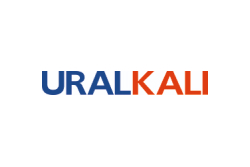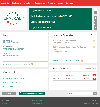Uralkali Announces IFRS 1H 2021 Financial Results

Uralkali (the Company), one of the world’s largest potash producers, announces its interim financial reporting for the six months ended 30 June 2021 prepared in accordance with IFRS1.
1H 2021 FINANCIAL HIGHLIGHTS:
As compared to the same period of 2020
- Revenue up 10% y-o-y to US$ 1,460 million
- Net revenue2 up 8% y-o-y to US$ 1,147 million
- EBITDA3 up 31% y-o-y to US$ 748 million
- EBITDA margin4 is 65%
- Cash COGS5 is US$ 35.3 per tonne
- Average FCA export price up 14% y-o-y to US$ 193 per tonne of potassium chloride (KCl)
1H 2021 OPERATIONAL HIGHLIGHTS:
As compared to the same period of 2020
- Production volume up 19% y-o-y to 6.2 million tonnes of KCl
- Sales volume down 2% y-o-y to 6.0 million tonnes of KCl
1H 2021 CORPORATE HIGHLIGHTS:
- In May, the Annual General Meeting of Uralkali shareholders decided not to pay dividends on the outstanding ordinary and preferred shares of the Company for 2020;
- In June, Uralkali for the first time in its history and the first among producers of mineral fertilizers in Central and Eastern Europe signed a sustainability-linked syndicated loan agreement with 18 banks for US$ 1,250 million.
Vitaly Lauk, Uralkali CEO, commented:
Gradual recovery of demand in our key consumption markets, against the general increase in potash prices, enabled the Company to demonstrate healthy financials in the reporting period. Industry fundamentals remain strong and we hope the market conditions will continue to improve in the second half of the year.
Key production and operating results:
|
|
1H 2021 |
1H 2020 |
|
Revenue (US$ million) |
1,460 |
1,323 |
|
Net revenue (US$ million) |
1,147 |
1,062 |
|
EBITDA (US$ million) |
748 |
570 |
|
EBITDA margin |
65% |
54% |
|
Gains/(losses) from foreign exchange differences and fair value revaluation of derivative financial instruments (US$ million) |
130 |
(499) |
|
Net profit/(loss) (US$ million) |
535 |
(180) |
|
Average export KCl price, FCA (US$) |
193 |
170 |
|
Production (KCl, million tonnes) |
6.2 |
5.2 |
|
Sales (KCl, million tonnes) — TOTAL — Domestic — Export |
6.0 1.4 4.6 |
6.1 1.3 4.8 |
Financial review
In 1H 2021, the growth of potash prices and demand in the global potash market had a positive impact on the Company’s key financial indicators including revenue and EBITDA. Net profit for the reporting period for US$ 535 million, which was a significant improvement year-on-year mainly related to an opposite in effect of foreign exchange differences and fair value revaluation of derivative financial instruments along with an increase in operating profits.
As of the end of June 2021, the Company’s net debt amounted to US$ 4,488 million.
The ratio of net debt/EBITDA for the last 12 months amounted to 3.21x, while Uralkali’s average interest rate for its loan portfolio for the first six months of 2021 was 2.84% in US$ and 1.73% in Euro.
Operational review
In 2021, Uralkali continued its investment programme aimed at production expansion including the following key projects:
- Construction of the Ust-Yayva mine, where construction of surface and underground facilities continues;
- Construction of the new (Southern) Solikamsk-2 mine, where shaft sinking and construction of surface facilities are underway;
- Expansion of the Solikamsk-3 mine, with continued construction of surface and underground facilities;
- Construction of the Polovodovsky potash plant, where preparation of construction site continues.
Uralkali is implementing a range of technology improvement, cost-cutting and equipment replacement projects.
The Company continues to comprehensively monitor the situation at Berezniki-1 and
Solikamsk-2 and backfill the mined-out areas at all operating mines. All activities are being carried out as planned and according to schedule.
Market review6
In the first half of 2021, the global potash market conditions were favourable, which reflects the operating results of the Company. During the reporting period, there was a steady upward trend in potash prices in key spot markets, with predominant growth in the second quarter of the year, as well as increase in global potash deliveries amid record major crops price levels supported by strong global demand, and reducing potash inventories in key regions due to limited supply.
Exceptionally favorable fundamentals for key crops (in particular, soybeans) in Latin America have led to high muriate of potash demand: in the first half of 2021, Brazil saw a new record level of imports of potassium chloride — about 5.1 million tonnes (+9% compared to same period last year). According to forecasts, the annual demand for potassium chloride in Latin America will increase relative to the level of 2020 and may exceed 15 million tonnes.
In North America, amid growing acreage relative to 2020, high crop prices and availability of potash fertilizers, despite a significant increase in spot prices, demand for potassium chloride is expected to show a steady increase year-on-year.
China remains the main consumer of potassium chloride in the world. At the end of the first half of 2021, the volume of imports of potassium chloride amounted to 4.6 million tonnes, which is 18.5% higher than last year. Despite the lower volume of sea deliveries under the concluded contracts due to the relatively low contract price achieved, potassium chloride consumption is expected to remain stable by the end of the year — possible decrease in imports is expected to be offset by potash inventories reduction and rise in domestic production.
In India, the volume of potassium chloride imports is expected to show a significant reduction: in the first half of 2021 the volume of imports amounted to about 1.5 million tonnes, which is almost a quarter lower than in the same period last year. Against the background of low contractual volumes to be delivered to Indian importers, potash stocks within the country are steadily decreasing. According to forecasts, potassium chloride deliveries will amount to about 4 million tonnes by the end of the year.
There is a rebound in potassium chloride demand in Southeast Asia due to favorable weather conditions and high palm oil prices, resulting in increased potash availability. The volume of imports to Indonesia and Malaysia (the main consumers of potash in the region) is significantly higher than last year. Potassium chloride demand in Southeast Asia as of the end of the year is expected to show an increase compared to the last year amid high crop prices and a recovery in demand for potash for NPK fertilizers production.
In Europe, Africa and the Middle East, the demand for potassium chloride was stable in the first half of 2021.
Domestic deliveries amounted to 1.4 million tonnes in the first half of 2021, which is 12% higher than in the same period last year, mainly due to increased sales to complex fertilizers and agricultural producers.
According to the Company’s expectations, global potassium chloride deliveries by the end of 2021 will amount to 70-71 million tonnes.
Uralkali (www.uralkali.com) is one of the world’s largest potash producers and exporters. The Company’s assets consist of 5 mines and 7 ore treatment plants in the towns of Berezniki and Solikamsk (Perm Region, Russia). Uralkali employs more than 12,000 people in the main production unit.
1 Interim condensed consolidated financial statements of PJSC Uralkali and its subsidiaries for the first half of 2021 have been reviewed by AO Deloitte & Touche CIS and can be found on Uralkali’s website at the following link
2 Net Revenue is revenue net of freight, railway tariff, rental of railway cars and transshipment cost3 Adjusted EBITDA is calculated as Operating Profit adjusted for depreciation of property, plant and equipment and right-of-use assets, amortization of intangible assets, impairment and gain/(loss) on disposal of non-current assets, unplanned contributions as well as expenses related to COVID-19 response measures
4 EBITDA margin is calculated as EBITDA divided by Net Revenue
5 Excluding goods for resale
6 Sources: Uralkali’s estimates, IFA data, customs statistics, financial statements of potash producers


